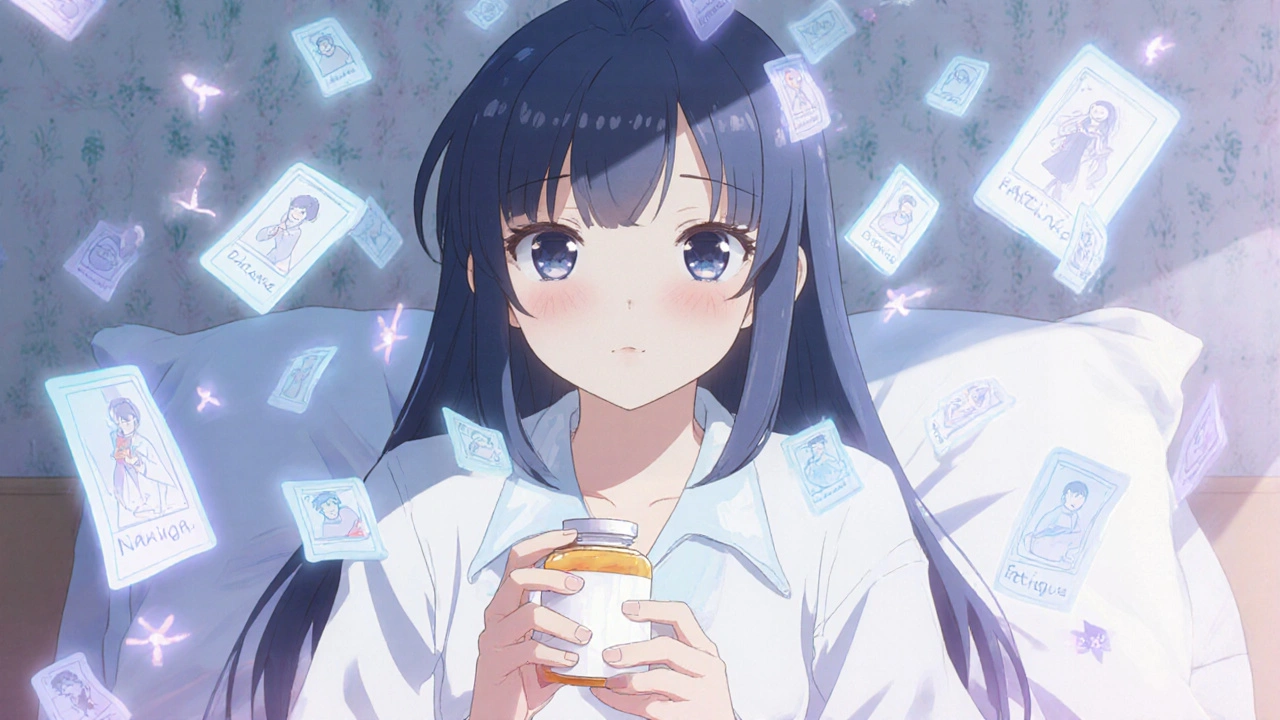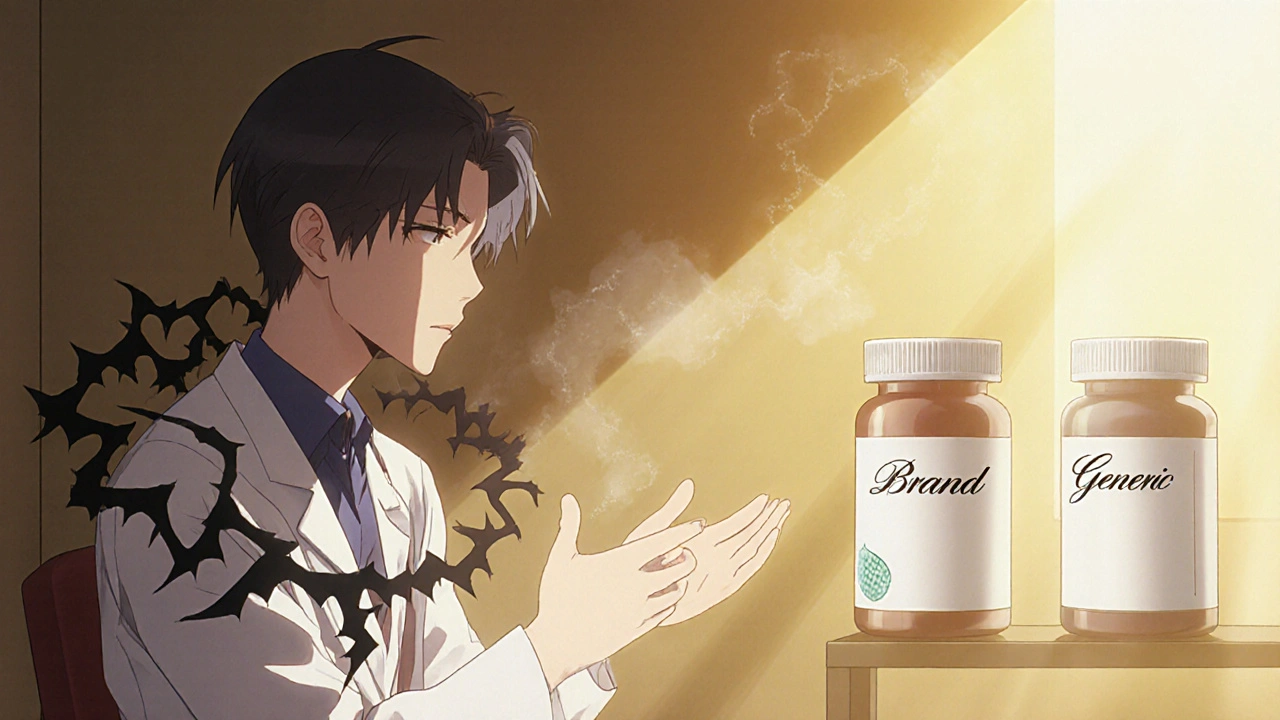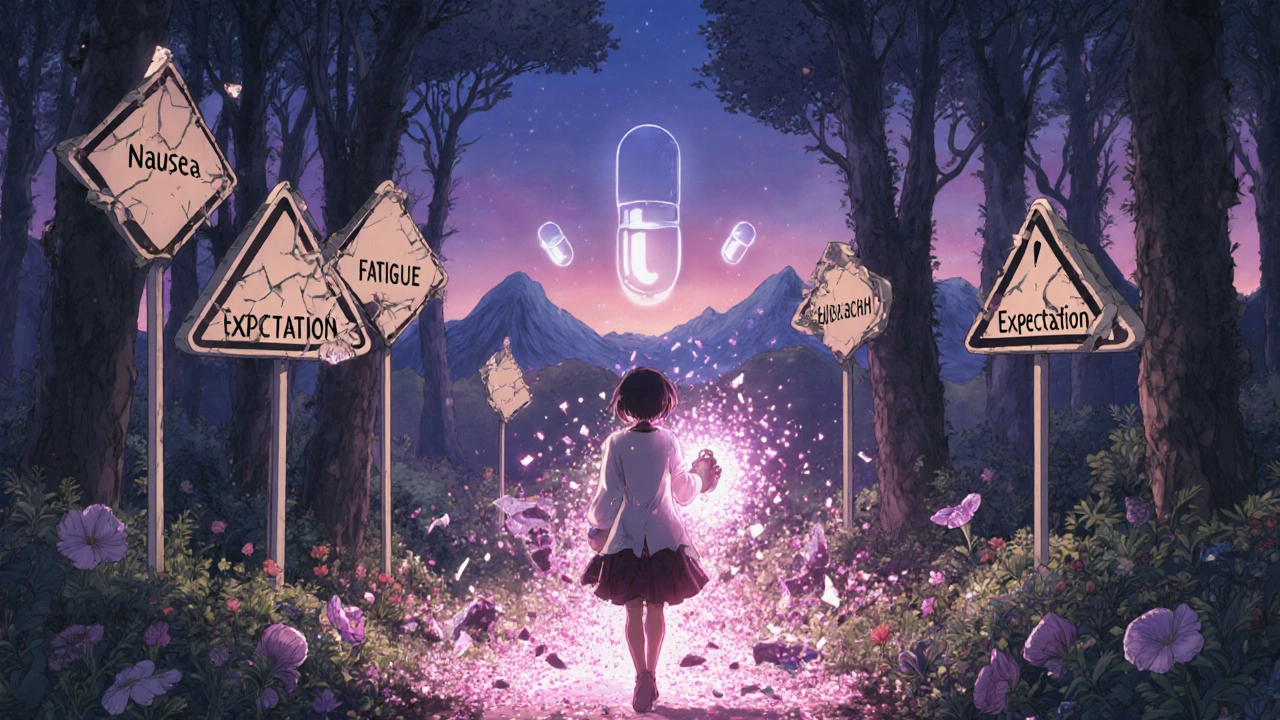
What if the side effects you feel from your medication aren’t caused by the drug at all - but by what you expect to happen? This isn’t science fiction. It’s the nocebo effect, a real and powerful force shaping how people experience medicine every day.
Imagine you’re prescribed a new pill for anxiety. You read the leaflet. It lists 17 possible side effects: nausea, dizziness, insomnia, fatigue, even weight gain. A week later, you start feeling tired. Your stomach feels off. You assume it’s the medication. So you stop taking it. But here’s the twist: the pill you took was a sugar pill - a placebo. The symptoms were real to you, but they weren’t caused by chemistry. They were caused by fear.
This happens more often than you think. In clinical trials, about 20% of people taking a dummy pill report side effects. Nearly 1 in 10 quit the trial because they felt worse. And it’s not just in studies. In real life, when patients switch from a brand-name drug to a cheaper generic version - even when the active ingredient is identical - many suddenly report new side effects. Why? Because they believe the generic won’t work as well. Their minds trigger physical reactions, even when there’s no chemical reason for them.
How the Nocebo Effect Works in Your Brain
The nocebo effect isn’t just ‘thinking too much.’ It’s biology. When you expect something bad to happen - like nausea, pain, or drowsiness - your brain activates the same areas that process real physical harm. Studies using fMRI scans show that the anterior cingulate cortex, the insula, and parts of the prefrontal cortex light up. These are the same regions involved in pain, stress, and bodily awareness.
It’s like your brain has a built-in alarm system. If you’re told, ‘This drug can cause headaches,’ your brain starts scanning for any little throb. You might have had a mild headache yesterday from stress or lack of sleep. But now, your brain labels it as ‘side effect.’ That’s misattribution. You’re not imagining it - you’re just misreading your body’s signals.
And it doesn’t stop there. Negative expectations can actually cancel out the benefits of real medication. In one study, patients given the powerful painkiller remifentanil felt much less pain when they were told it would help. But when they were told it might make their pain worse after the initial relief, the drug’s effect vanished completely. The expectation wiped out the chemistry.
It’s Not Just You - It’s the Information You’re Given
Where do these negative expectations come from? Often, from the very materials meant to protect you: the patient information leaflet. These documents are required by law to list every possible side effect, no matter how rare. A typical antidepressant leaflet might list 30+ side effects. Some occur in fewer than 1 in 1,000 people. But when you read them all, your brain doesn’t think in percentages. It thinks in possibilities: ‘What if that’s me?’
Research shows a direct link: the more side effects listed, the more patients report them. In one study, people given a leaflet with 15 side effects reported twice as many symptoms as those given a leaflet with only 5 - even when they were all taking the same placebo.
Doctors and pharmacists also play a role. Saying, ‘Some people get serious nausea with this drug,’ sets a different tone than, ‘Most people feel fine, but a small number may feel a bit queasy for a few days.’ The wording matters. A 2021 European survey found that 68% of physicians have seen patients develop symptoms after being warned about them - even when the symptoms weren’t there before.
Who’s Most at Risk?
Not everyone experiences the nocebo effect the same way. Certain people are more vulnerable:
- Women - in placebo trials, women report side effects 23% more often than men.
- People with anxiety or depression - they’re 1.7 times more likely to develop nocebo symptoms.
- Pessimistic thinkers - if you tend to expect the worst, your brain is primed to find it.
- Those who’ve had bad experiences with medication before - past trauma with drugs can create lasting expectations.
It’s not about being ‘weak-minded.’ It’s about how your brain learns from experience, language, and fear. If you’ve ever had a bad reaction to a drug, your brain files that away as a warning. Next time, even a tiny change - like a different pill color - can trigger the same response.

The Real Cost: Discontinued Medications and Lost Health
The nocebo effect isn’t just a curiosity - it’s a public health issue. An estimated 15-20% of patients stop taking effective medications because they believe they’re causing side effects. Many of those side effects are nocebo-driven.
Take New Zealand’s 2017 switch from brand-name venlafaxine to a generic version. Before the change, adverse effect reports were stable. After media coverage warned patients about the switch, reports spiked - even though the active ingredient hadn’t changed. Patients weren’t reacting to the drug. They were reacting to the fear.
Similar patterns show up with antidepressants, blood pressure meds, and cholesterol drugs. People stop taking them. Their condition worsens. They end up in the hospital. The cost? Billions in avoidable healthcare spending. And the human cost? Lost months of stability, increased risk of relapse, and unnecessary suffering.
How to Fight the Nocebo Effect
The good news? You can reduce its impact - without hiding information.
Healthcare providers are learning to reframe how they talk about side effects. Instead of saying, ‘This drug can cause severe dizziness,’ they say, ‘Most people don’t feel dizzy at all. If you do, it’s usually mild and goes away after a few days.’ This doesn’t sugarcoat - it contextualizes.
Patients can help too:
- Ask your doctor: ‘How common is this side effect really?’
- Don’t assume every new symptom is from the drug. Could it be stress? Sleep? A cold?
- Give the medication time. Many side effects fade in the first week or two.
- Keep a simple log: note when symptoms happen, what else was going on, and whether they improve over time.
Some clinics in the UK and Europe have started training staff in nocebo-aware communication. After just 4-6 hours of training, doctors saw a 14-22% drop in patients quitting their meds. That’s not magic. It’s better conversations.

The Bigger Picture: Medication Without Harm
The World Health Organization now lists ‘reducing nocebo effects’ as a key goal in its Medication Without Harm initiative. The goal isn’t to trick patients. It’s to give them the truth - without feeding fear.
Pharmaceutical companies are starting to take notice. Only 32% currently adjust their patient materials for nocebo risk, but that’s changing. Regulatory bodies like the European Medicines Agency and Medsafe (New Zealand) are drafting new guidelines for how side effects should be presented - clear, balanced, and grounded in real likelihood.
Future research is exploring ‘open-label placebos’ - giving patients real sugar pills but telling them, ‘This pill has been shown to help people feel better even if it doesn’t contain active medicine.’ Early results are surprising: some patients still improve. That tells us something powerful: the mind’s ability to heal - or harm - is deeper than we thought.
Final Thought: Your Mind Is Part of the Medicine
You don’t have to believe in ‘positive thinking’ to understand this. The nocebo effect isn’t about being optimistic. It’s about being accurate. Your brain doesn’t distinguish between what’s real and what you expect to be real. It responds to both.
If you’re starting a new medication, remember: not every symptom is the drug’s fault. Not every bad feeling means you need to stop. And not every change in how you feel is a sign of failure - sometimes, it’s just your mind catching up.
Knowledge is power. But so is context. The right information, delivered the right way, doesn’t just inform - it protects.
Can the nocebo effect cause real physical symptoms?
Yes. The nocebo effect doesn’t just make you feel like something’s wrong - it triggers real physiological changes. Your brain can activate stress pathways, increase muscle tension, raise cortisol levels, and even alter pain perception. These aren’t imaginary symptoms. They’re measurable biological responses driven by expectation.
Are nocebo effects the same as psychosomatic symptoms?
They overlap, but they’re not the same. Psychosomatic symptoms arise from psychological stress, like anxiety causing stomach pain. The nocebo effect is more specific: it’s triggered by expectations about a particular treatment. You don’t need to be anxious overall - just worried about the drug. That’s why someone can feel fine most days but suddenly get headaches after reading a medication leaflet.
Why do generic drugs seem to cause more side effects than brand-name ones?
They don’t - at least not chemically. The active ingredient is identical. But patients often believe generics are inferior. When they switch, they start looking for side effects. Their heightened awareness leads them to notice normal bodily sensations - fatigue, mild dizziness - and blame the drug. This is a classic nocebo response, proven in multiple studies, including the New Zealand venlafaxine case.
Can doctors prevent the nocebo effect without hiding risks?
Yes. The key is framing. Instead of saying, ‘1 in 5 people get nausea,’ say, ‘Most people don’t have nausea, but if you do, it’s usually mild and lasts only a few days.’ This gives the truth without planting fear. Studies show this approach maintains informed consent while reducing nocebo reactions by up to 22%.
Is the nocebo effect getting more common?
It’s not necessarily more common - but we’re seeing it more clearly. With better research, more patient access to information (and misinformation), and increased awareness among doctors, we’re now recognizing patterns we once dismissed as ‘anxiety’ or ‘non-compliance.’ The rise of online forums and detailed drug leaflets has amplified exposure to negative expectations, making the effect more visible.
Ravi Singhal
November 2, 2025 AT 06:53bro i took a sugar pill last week and swore i felt like a zombie for two days. turned out i was just dehydrated and watched too much netflix. mind is wild.
Victoria Arnett
November 3, 2025 AT 00:13i used to blame my meds for every headache until i realized i got them every time i skipped coffee. the nocebo thing is real but so is caffeine withdrawal lol
HALEY BERGSTROM-BORINS
November 4, 2025 AT 04:14THIS IS A GOVERNMENT COVER-UP. 🕵️♀️ They know the pills are toxic but they don't want you to know. The leaflets? Designed to confuse you. The FDA? Bought and paid for. I saw a guy on YouTube who stopped all meds and his cancer vanished. Coincidence? I think not. 🧪💉 #NoceboIsAScam
Sharon M Delgado
November 5, 2025 AT 19:51Oh my goodness, this is so important! I’ve been saying this for years! The language! The tone! The way doctors say ‘this could cause severe dizziness’ instead of ‘most people feel fine’-it’s not just semantics, it’s psychological warfare! And don’t get me started on the color of the pill-blue pills make me feel more anxious than red ones, I swear it! 🌈
Dr. Marie White
November 6, 2025 AT 21:38This resonates deeply. I’ve seen patients stop life-saving meds because they read a 40-item side effect list and panicked. One woman stopped her blood pressure med after reading ‘possible hair loss’-she’d never lost a single strand. Her BP skyrocketed. We need better communication, not less info. Just… kinder info.
Wendy Tharp
November 7, 2025 AT 12:05People are just weak. If you can’t handle a little nausea, maybe you shouldn’t be on meds at all. Stop blaming your mind. Just take it like a grown-up. Also, generics are cheaper for a reason-they’re not as strong. You get what you pay for.
Subham Das
November 9, 2025 AT 04:02One must contemplate the epistemological rupture between pharmacological substance and phenomenological experience-when the Cartesian mind, haunted by semiotic dread encoded in pharmaceutical pamphlets, begins to somatize its own ontological insecurity. The pill is not the cause; the signifier is. The leaflet, as Lacanian objet petit a, becomes the true agent of corporeal dissonance. One does not merely fear side effects- one is colonized by their linguistic possibility.
Cori Azbill
November 10, 2025 AT 06:20USA is the only country that lets Big Pharma write the leaflets. In Germany, they only list what actually happens to 1% of people. Here? They list every single thing that’s ever been reported-even if it happened once in 1987 to a guy in Nebraska who also ate expired cheese. We’re being manipulated.
Paul Orozco
November 10, 2025 AT 12:54Wait, so you're saying people who feel bad after taking medicine are just being dramatic? That’s not helpful. What if they’re actually sick? You’re dismissing real suffering because you think it’s ‘all in their head.’ That’s dangerous. And also, I’ve been on 12 different meds. I know what I’m talking about.
Bobby Marshall
November 10, 2025 AT 15:44Man, this hit me right in the soul. I used to freak out every time I took a new pill-then I started journaling. Turned out 80% of my ‘side effects’ were just stress or bad sleep. I still take my meds. I just don’t panic anymore. My body’s not the enemy. My fear was.
Ardith Franklin
November 11, 2025 AT 23:34Of course this is real. They’ve been doing this since the 1950s. Placebo-controlled trials? Designed to make drugs look safe. The ‘side effects’ are just the ones they didn’t want you to notice. And don’t even get me started on the color of the pill-white pills = depression, blue pills = anxiety. It’s all coded. I’ve seen the documents.
Jenny Kohinski
November 11, 2025 AT 23:50This is so comforting 😊 I used to feel guilty for stopping my meds because I ‘felt weird’-but now I realize it might’ve been the leaflet, not the drug. I’m going to ask my doctor to reframe things next time. Thank you for writing this 💛
Aneesh M Joseph
November 12, 2025 AT 20:50Generic drugs are junk. I tried one once. Felt like crap. Back to brand name. Case closed. Nocebo? Nah. Just bad chemistry.
Deon Mangan
November 13, 2025 AT 18:17Let me be the first to say: you’re all missing the point. The nocebo effect isn’t just about pills-it’s about trust. When your doctor rushes through the leaflet, when your pharmacist doesn’t answer your questions, when the system treats you like a data point... your brain goes into survival mode. And guess what? It finds the threat. Even if it’s just a typo on page 12. This isn’t psychology. It’s systemic neglect. And we’re paying for it. With our health. With our lives. 🤖